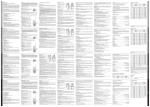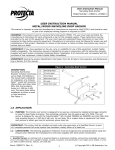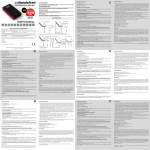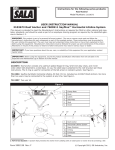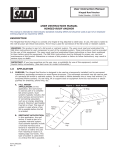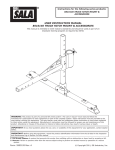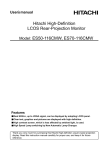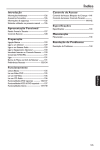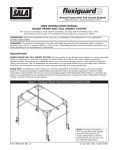Download FlexiGuard Portable C-Frame Rail Fall Arrest System Manual
Transcript
EN795: 1996 Class B The Ultimate in Fall Protection CE Type Test CE Production Quality Control No. 0086 BSI Product Services P.O. Box 6221, Kitemark Court Davy Avenue Milton Keynes MK1 9EP UK No. 0086 BSI Product Services P.O. Box 6221, Kitemark Court Davy Avenue Milton Keynes MK1 9EP UK C-Frame Rail Fall Arrest System Model Numbers: 8517700 8517701 8517702 8517703 8517704 8517705 8517706 8517707 8517708 8517709 8517710 8517711 8517712 8517713 8530035 8530111 8530115 8530119 8530205 8530212 8530213 8530223 8530225 8530235 8530246 8530262 8530274 8530317 8530319 8530354 8530414 8530446 8530471 8530505 User Instruction Manual WARNING: This product is part of a fall arrest system. These instructions must be provided to all users and rescuers (see Section 9 Terminology) using this equipment. The user must read and understand these instructions before assembling or using this equipment. The user must follow the manufacturer’s instructions for each component of the system. Manufacturer’s instructions must be followed for proper use and maintenance of this equipment. Alterations or misuse of this equipment, or failure to follow instructions, may result in serious injury or death. IMPORTANT: Before using this equipment record the product identification information from the ID label in the ‘Inspection and Maintenance Log’ at the back of this manual. IMPORTANT: If you have questions on the use, care, application, or suitability for use of this safety equipment, contact Capital Safety. EMPLOYEE TRAINING: This manual is intended to meet industry standards, including OSHA, ANSI Z359.1, and CE EN795 and should be used as part of an employee training program as required by OSHA. FORM NO: 5902343 REV: B © Copyright 2013, Capital Safety DESCRIPTION C-Frame Rail Fall Arrest System with two trolleys for moveable fall arrest protection. 1.0 1.1 APPLICATIONS PURPOSE: Personal Protective Equipment against falls from a height. The C-Frame Rail Fall Arrest System (C-Frame FAS) with Fall Protection combines easy access to elevated work areas with fall protection from the ground for the duration of the work being performed. The system includes a height-adjustable horizontal rail and two trolleys that can be moved to any position along the rail. The trolleys serve as attachment points for the anchorage of a Personal FallArrest System (PFAS). The system can be moved by hand, by a forklift or towed by a maintenance vehicle when equipped with proper accessories. 1.2 LIMITATIONS: The following application limitations must be considered before using this product. Failure to observe product limitations could result in serious injury or death. A. ASSEMBLY: The rail system must be assembled in accordance with the requirements stated in the Assembly Instructions Manual for this product (PN 5902343). B. CAPACITY: The maximum working load for this product is two persons with a combined weight of 310 lbs. (141 kg) per person. C. PERSONAL FALL ARREST SYSTEMS: Personal fall arrest systems used with the C-Frame FAS must meet applicable state and federal regulations, or CE regulations, and the requirements stated in section 4.3. D. PHYSICAL AND ENVIRONMENTAL HAZARDS: Use of this equipment in areas with physical or environmental hazards may require that additional precautions be taken to reduce the possibility of damage to this equipment or injury to the user. Hazards may include, but are not limited to: high heat (welding or metal cutting), acid or caustic chemicals, corrosive environments such as exposure to seawater, high voltage power lines, explosive or toxic gases, moving machinery or sharp edges. Contact DBI-SALA if you have questions about the application of this equipment in areas where physical or environmental hazards are present. E. TRAINING: This equipment is to be assembled, installed and used by persons who have been trained in its correct application and use. 1.3 Refer to national standards, including the ANSI Z359 family of standards .0, .1, .2, .3, and .4, local, state, and OSHA requirements, and CE standards where applicable, for more information on the application of this and associated equipment. WARNING: Do not alter or intentionally misuse this equipment. 2 WARNING: Working at height has inherent risks. Some risks are noted here but are not limited to the following: falling, suspension/prolonged suspension, striking objects, and unconsciousness. In the event of a fall arrest and/or subsequent rescue (emergency) situation, some personal medical conditions may affect your safety. Medical conditions identified as risky for this type of activity include but are not limited to the following: heart disease, high blood pressure, vertigo, epilepsy, drug or alcohol dependence, psychiatric illness, impaired limb function and balance issues. We recommend that your employer/ physician determine if you are fit to handle normal and emergency use of this equipment. Figure 1 - C-Frame Rail Fall Arrest System A SRL Attachment Point A A 3 2.0 SYSTEM REQUIREMENTS 2.1 COMPATIBILITY OF COMPONENTS: DBI-SALA equipment is designed for use with DBI-SALA approved components and subsystems only. Substitutions or replacements made with non-approved components or subsystems may jeopardize compatibility of equipment and may effect the safety and reliability of the complete system. 2.2 COMPATIBILITY OF CONNECTORS: Connectors are considered to be compatible with connecting elements when they have been designed to work together in such a way that their sizes and shapes do not cause their gate mechanisms to inadvertently open regardless of how they become oriented. Contact DBI-SALA if you have any questions about compatibility. Connectors (hooks, carabiners, and D-rings) must be capable of supporting at least 5,000 lbs. (22.2kN). Connectors must be compatible with the anchorage or other system components. Do not use equipment that is not compatible. Non-compatible connectors may unintentionally disengage (see Figure 6). Connectors must be compatible in size, shape, and strength. Self-locking snap hooks and carabiners are required by ANSI Z359.1 and OSHA. 2.3 CONNECTIONS: Only use self-locking snap hooks and carabiners with3this equipment. Only use connectors that are suitable to each application. Ensure all connections are compatible in size, shape and strength. Do not use equipment that is not compatible. Ensure all connectors are fully closed and locked. Figure 2 - Unintentional Disengagement (Rollout) If the connecting element to which a snap hook (shown) or carabiner attaches is undersized or irregular in shape, a situation could occur where the connecting element applies a force to the gate of the snap hook or carabiner. This force may cause the gate (of either a self-locking or a non-locking snap hook) to open, allowing the snap hook or carabiner to disengage from the connecting point. Small ring or other noncompatibly shaped element 1.FORCE IS APPLIED TO THE SNAP HOOK. 2. THE GATE PRESSES AGAINST THE CONNECTING RING 4 3. THE GATE OPENS ALLOWING THE SNAP HOOK TO SLIP OFF DBI-SALA connectors (snap hooks and carabiners) are designed to be used only as specified in each product’s user instructions. See Figure 3 for inappropriate connections. DBI-SALA snap hooks and carabiners should not be connected: A. To a D-ring to which another connector is attached. B. In a manner that would result in a load on the gate. NOTE: Large throat snap hooks should not be connected to standard size D-rings or similar objects which will result in a load on the gate if the hook or D-ring twists or rotates. Large throat snap hooks are designed for use on fixed structural elements such as rebar or cross members that are not shaped in a way that can capture the gate of the hook C. In a false engagement, where features that protrude from the snap hook or carabiner catch on the anchor, and without visual confirmation seems to be fully engaged to the anchor point. D. To each other. E. Directly to webbing or rope lanyard or tieback (unless the manufacturer’s instructions for both the lanyard and connector specifically allows such a connection). F. To any object which is shaped or dimensioned such that the snap hook or carabiner will not close and lock, or that roll-out could occur. Figure 3 - Inappropriate Connections 5 3.0 OPERATION AND USE WARNING: Consult DBI-SALA when using this equipment in combination with components or subsystems other than those described in this manual. Some subsystem and component combinations may interfere with the operation of this equipment. Use caution when using this equipment around moving machinery, electrical hazards, chemical hazards, and sharp edges. 3.1 BEFORE EACH USE: Inspect this equipment carefully to ensure it is in good working condition. Check for worn or damaged parts. Ensure all parts are present and secure. Check the entire system for damage and corrosion. See section 5.0 for further inspection details. Do not use if inspection reveals an unsafe condition. 3.2 PLANNING: Plan your system and how it will function before starting your work. Consider all factors that affect your safety during use. Some important points to consider when planning your system are: A. HAZARD EVALUATION: Evaluate job site hazards prior to starting work. Consult applicable OSHA (or CE) and industry standards for guidelines and regulatory requirements on issues such as personal fall arrest systems (PFAS). B. WORK SITE GEOMETRY: The use of the FSHRS must be consistent with the geometric requirements stated in the associated manufacturer’s instruction manuals. Check for obstructions or sharp edges in the work path. Avoid working where the user may swing and hit an object, or where lines may cross or tangle with that of another worker. C. RESCUE: When using this equipment, the employer must have a rescue plan and the means at hand to implement it and communicate that plan to users, authorized persons, and rescuers. D. 3.3 AFTER A FALL: Any equipment which has been subjected to the forces of arresting a fall or exhibits damage consistent with the effect of fall arrest forces as described in section 5, must be removed from service immediately and destroyed by the user, the rescuer, or an authorized person. REQUIREMENTS FOR PERSONAL FALL ARREST SYSTEMS (PFAS): PFAS used with the FSHRS must meet applicable OSHA requirements. • The PFAS should be rigged to minimize any potential free fall and never allow a free fall greater than 6 ft. (1.8 m). The PFAS used with this equipment are required to include a full body harness as the body support component. PFASs that incorporate full body harnesses must maintain fall arrest forces below 1,800 lbs. (8.0 kN) and arrest the fall within 42 in. (1.1 m). Body belts, unless incorporated into a full body harness, are not allowed for use with this equipment. A typical PFAS includes a full body harness, connecting subsystem or component (self retracting lifeline or shock absorbing lanyard), and the necessary connectors to couple the system together. • PFAS may only be attached to the two FSHRS trolleys which move along the rail. See Figure 1 (A). 6 WARNING: Read and follow manufacturer’s instructions for the personal fall arrest equipment selected for use with the C-Frame FAS. IMPORTANT: Body belts are not allowed for free fall situations. Body belts increase the risk of injury during fall arrest in comparison to a full body harness. Limited suspension time and the potential for improperly wearing a body belt may result in added danger to the user’s health. 3.4 TRAINING: It is the responsibility of the user to assure they are familiar with these instructions, and are trained in the correct care and use of this equipment. User must also be aware of the operating characteristics, application limits, and the consequences of improper use of this equipment. IMPORTANT: Training must be conducted without exposing the trainee to a fall hazard. Training should be repeated on a periodic basis. 3.5 PROCEDURE FOR USE OF THE RAIL SYSTEM: Figure 4 - Procedure for Use (1 of 3) 5FT to 9FT (1.5m to 3m) above work surface 2 2 2 3 7 1 Figure 5 - Procedure for Use (2 of 3) 4 MIN 5 FT (1.5m) MAX 9 FT (3m) above work surface 6 FT (1.8m) MAX 6 FT (1.8m) C L Step 1. Move the unit 1 to 3 feet (0.3-1m) away from work area/object. Step 2: Adjust the rail height to be 5 to 9 feet (1.5- 3m) above the work surface (1, Figure 4). Rail height is adjusted by cranking the drive handle (2, Figure 4). Clockwise rotation of the drive handle will increase rail height; counterclockwise rotation of the drive handle will reduce rail height. Step 3: Push the unit into position so that the rail is close to the center of the work area to maximize the safe work area and reduce the chances of a potential fall. Wheels and jacks (3, Figure 4) must be positioned over a stable, level surface or leveled with blocks. Step 4: Lower the jacks down and apply light pressure by just contacting the surface. Lock the wheels. Readjust rail height if necessary (see Step 2). Step 5: If applicable, pull down the tag line to connect to the SRL (4, Figure 5; SRL not provided). Use a full body harness to safely access the work area. NOTE: The SRL line must not drag or bend over a leading edge while accessing the work area. To eliminate that problem reposition the unit. Follow the SRL manufacturer’s instructions carefully. 8 Figure 6 - Procedure for Use (3 of 3) MAX 6 FT (1.8m) MAX 6 FT (1.8m) MAX 6 FT (1.8m) MAX 6 FT (1.8m) 5 IMPORTANT: follow the safe working area instruction carefully. If using an SRL more than 10 feet in length carefully follow the safe working area guidelines as shown in Figure 6. IMPORTANT: follow the safe working area instruction carefully. If using an SRL more than 10 feet in length carefully follow the safe working area guidelines as shown in Figure 6. Step 6: If applicable, transfer the tag line to the SRL on the working anchor point trolley. Follow guidelines for the safe working area carefully. Do not exceed the safe working area (5, Figure 6) under any circumstances. Step 7: Maximum of two operators can be attached to the unit, each using an individual trolley. No more than one person can be attached to a single trolley at anytime. 4.0 4.1 TRAINING It is the responsibility of users to make certain they are familiar with these instructions and are trained in the correct care and use of this equipment. 9 5.0 INSPECTION MAINTENANCE/INSPECTION SAFETY: 1. Read, understand and follow the User Manual and signs on the equipment before using, maintaining or inspecting the equipment. Equipment must have a complete inspection performed during setup and before first use. 2. Follow the inspection procedure contained in this of any other applicable the manual and use the inspection form(s) to document the results. 3. Keep instructional and safety labels clean and legible at all times. Clean or replace as required. See Section 7 for label information and part numbers. 4. Remove the equipment from service if a problem is found during the inspection using a lockout/tagout procedure. Repairs must be done by an authorized repair depot or the factory for service center. WARNING: If theC-Frame Rail Fall Arrest System (C-Frame FAS) has been subject to impact forces from fall arrest, it must be immediately removed from service and inspected. If the C-Frame FAS fails to pass inspection, do not use. The equipment must be repaired by an authorized service center. IMPORTANT: Extreme working condition (harsh environment, prolonged use, etc.) may require increased frequency of inspections. 5.1 VISUAL INSPECTION: A complete visual inspection should be performed on the C-Frame FAS equipment you are using prior to the operation. The following items should be checked, and result recorded on the “Inspection and Maintenance Log” in at the back of this manual. Step 1. Labels: Check that all labels are clean and legible. Clean the labels if any are dirty using mild soap and damp cloth. Replace if any are illegible (Refer to Section 7 for a listing of all labels). Step 2. Turnbuckle/Cable Assemblies: Inspect turnbuckles and cables: • Turnbuckles - Inspect turnbuckles (Figure 7) for damage and proper adjustment. • Cables - Check cable assemblies for slack. Cables must be tight enough to apply slight pressure on the unit. DO NOT OVERTIGHTEN. Inspect cables for kinks, cuts, crushed sections, burned areas, or other flaws (see Figure 8). 10 Figure 7 - Turnbuckle Step 3. Figure 8 - Cable Flaws A Kinked Wire Rope B Broken Wires C Bird-Caging D Welding Splatter Rail Support Assemblies: Inspect the rail support assemblies (Figure 9): • Defects or Damage - Check rail supports for structural defects or damage. • Fasteners - Check for visually loose fasteners. • Overload Detection Gusset - This gusset is an indicator of a previous fall or misuse/abuse. These gussets are located on each rail support assembly (see Figure 9). Inspect the gussets visually for straightness and to ensure there is no visible deformation or bend; indicating an incident. Please ensure the proper M.A.F. device is used for this product and read all labels (see Section 7) prior to use. This gussets not only provide visual indication of a fall or misuse but also provide protection against damage to the other C-Frame FAS components and reduces costly repairs to the unit. Figure 9 - Rail Support Assembly Inspection A Gusset B Fasteners A B 11 Step 4. Rail Assembly: Check the rail and trolley for structural defects (see Figure 10). Rail track must be straight without dents or bends. If structural defects are found remove from service immediately. • Fasteners - Check for visually loose fasteners along the length of the rail. • Trolley - Check for structural damage to the trolley and ensure free movement in the rail. Figure 10 -Rail Assembly Inspection A Rail B Trolley A B Step 5. Step 6. Drive Mechanism: Lubricate the drive mechanisms (see Section 6 and Figure 16) and inspect the following components: • Brake Wear Indicator - Check brake wear indicator (Figure 11) while lowering the unit. If the indicator is in the red area, remove from service and contact the manufacturer. • Fasteners - Visually inspect for loose fasteners (Figure 11). • Chain - Visually inspect the chain (Figure 11) for slack. Deflection should not be more than 13 mm (1/2 in.). • Drive Connector Bar - Visually check the drive connector bar (Figure 11) for loose fasteners. Vertical Upright Assemblies: Inspect the vertical upright assemblies (Figure 12): • Defects or Damage - Check for defects or structural damage. • Fasteners - Check for visually loose fasteners. IMPORTANT: Do not adjust threaded rods. They are preset by the manufacturer. Step 7. Leg Assemblies: Inspect leg assemblies (Figure 12) for structural damage. 12 Figure 11 - Drive Mechanism Inspection A Brake Wear Indicator B Fasteners C Chain D Drive Connector Bar C A B D B Figure 12 - Vertical Upright Assembly & Leg Assembly Inspection A Vertical Upright Assembly B Threaded Rod C Leg Assembly A C A B C 13 5.2 FUNCTIONAL INSPECTION: A functional check should be performed on the C-Frame FAS prior to every use. The following functional tests should be done; and the results recorded on the “Inspection and Maintenance Log”. Step 1. System Operation and Adjustments: The C-Frame FAS contains operational parts that include pulleys and/ or rollers (Figure 13 ). These parts must be carefully checked for chips, cracks, or worn areas that can cause malfunction during operation of the system. Make sure that all the adjustment points are in full functional condition. This may include parts that contain pins, bolts, tri-screws, and jacks. There are also mechanical adjustments which may include adjustable legs, sleeves, adjustable sliding legs, brackets and chain. These areas must be kept clean from debris and corrosion for proper functional use. If any part of the system that includes all listed items above becomes damaged contact your Capital Safety representative for parts and/or service. Step 2. SRL and other Accessory Inspection: Refer to the manufacturer’s user manual or instructional material for proper functional inspection procedures for SRLs and accessories not covered by this manual. 5.3 QUARTERLY INSPECTION: DETAILED INSPECTION POINTS: Inspect the following inspection points on a quarterly basis (see Figure 14): Step 1. Corrosion: Inspect the entire unit for corrosion. If there is corrosion, please consult the manufacturer for advisement. Step 2. Fasteners: Check all fasteners using a minimum of 20 N.m (15 ft.lbs) of torque. Unless otherwise specified, loose fasteners must be tightened to 34 N.m (25 ft.lbs). Refer to the following drawings to locate all fasteners: Component: Drawing #: Vertical Upright Assembly 26373, 26374 Drive Base Assembly 26392 Drive Assembly 26375, 26389 Rail Support Assembly 20558 Wheels, Swivels, and Brakes 26174, 26178, 26366, 24989 Fasteners must be checked and tightened to the following torques: Bolt Size and Grade: Torque Setting: 1/2 inch, Grade 5 30-35 ft-lbs (40-48 Nm) 1/2 inch, Grade 8 35-40 ft-lbs (48-54 Nm) 5/8 inch, Grade 8 35-40 ft-lbs (48-54 Nm) 14 Figure 13 - Roller Inspection A Roller A A A Figure 14 - Detailed Inspection Points A Drive B Drive Base C Carriage Assembly D Leg Assembly C A B D 15 5.4 YEARLY INSPECTION: Perform the following inspections annually: Step 1. Wheels: Check and lubricate with wheel bearing grease as required (see Figure 15). IMPORTANT: Do not overtighten wheel axle bolts. Wheels must rotate freely by hand. Figure 15 - Wheel Bearings A Bearings A Step 2. 6.0 Chain: Check and lubricate chains with light lubricant or WD-40 as required (see Section 6 and Figure 16). MAINTENANCE At regular intervals perform a detailed inspection of the equipment and document the results in the Inspection and Maintenance Log (Section 10). Remove the equipment from service if deficiencies are found. WARNING: Do not make alterations or additions to this equipment without prior written consent from Capital Safety. (Only the equipment manufacturer, or persons or entities authorized in writing by the manufacturer, can make repairs to this equipment.) 6.1 CLEANING: Periodically clean the rail system using mild detergent and a damp cloth. 6.2 LABELS: Clean labels and replace as needed. (See Section 7 for label examples.) 6.3 CHAIN LUBRICATION: Lubricate chains with light lubricant like WD-40 (See Figure 16). 6.4 BRAKE AND DRIVE LUBRICATION: Lubricate brake and drive components with a light lubricant like WD-40 (See Figure 16). 6.5 SYNCHRONIZING DRIVE CONNECTOR: If the synchronizing drive connector (see Figure 17) is removed for any reason, including during maintenance, it is critical NOT to crank the individual drives. This will cause an imbalanced height of the trolley rail which can cause serious injury or death 16 Figure 16 - Lubrication Figure 17 - Synchronizing Drive Connector 17 7.0 LABELS The following labels must be securely attached to the C-Frame FAS and fully legible. Proper maintenance of the labels must be established by the operator/entrant to keep system use safe. If labels are damaged the operator/entrant must enforce a lock-out/ tag-out procedure. New labels are available from the local dealer or manufacturer. F A DANGER 2x 4x D C A ELECTROCUTION HAZARD E WATCH FOR OVERHEAD POWER LINES B Pt#: 16399 G F B C WARNING MAXIMUM LIFT CAPACITY 5000 Lbs / 22kN DO NOT REMOVE THIS LABEL. FULLY RETRACT OR ROTATE JACK BEFORE TOWING. ENGAGE LOCKING PIN ON SWIVEL JACK BEFORE TOWING OR USING JACK. BLOCKS USED TO INCREASE HEIGHT CAN CAUSE INSTABILITY AND MAY CAUSE INJURY OR DEATH. Pt# 18723 Rev.01 D E WARNING WARNING Ensure the leg screws / jacks are in contact with the surface. To prevent instability, screw legs down to contact surface and crank the handle an extra 5 times, approximately one (1) inch of the screw leg. If the surface is uneven adjust accordingly. This product is approved for use with retractable devices and shock absorbers with a MAXIMUM ARRESTING FORCE (M.A.F.) RATING OF 900 lb (4 kN) OR LESS. Retractable devices and shock absorbers must be installed, maintained and used according to the manufacturer’s instructions. Pt# 13818 Pt# 8524261 Rev.03 G 18 8.0 SPECIFICATIONS Working Load: Maximum of two persons with a combined weight of 310 lbs. (141 kg) per person. Materials and Construction General Construction: Finish (Aluminum): Hardware Material: 9.0 Welded Steel/Aluminum Yellow Powder Coat Zinc Plated TERMINOLOGY Authorized Person: A person assigned by the employer to perform duties at a location where the person will be exposed to a fall hazard (otherwise referred to as “user” for the purpose of these instructions). Rescuer: Person or persons other than the rescue subject acting to perform an assisted rescue by operation of a rescue system. Certified Anchorage: An anchorage for fall arrest, positioning, restraint, or rescue systems that a qualified person certifies to be capable of supporting the potential fall forces that could be encountered during a fall or that meet the criteria for a certified anchorage prescribed in this standard. Qualified Person: A person with a recognized degree or professional certificate and with extensive knowledge, training, and experience in the fall protection and rescue field who is capable of designing, analyzing, evaluating and specifying fall protection and rescue systems to the extent required by this standard. Competent Person: One who is capable of identifying existing and predictable hazards in the surroundings or working conditions which are unsanitary, hazardous, or dangerous to employees, and who has authorization to take prompt corrective measures to eliminate them. 19 INSPECTION AND MAINTENANCE LOG SERIAL NUMBER: MODEL NUMBER: DATE PURCHASED: INSPECTION DATE Approved By: Approved By: Approved By: Approved By: Approved By: Approved By: Approved By: Approved By: Approved By: Approved By: Approved By: Approved By: Approved By: Approved By: Approved By: Approved By: Approved By: Approved By: DATE OF FIRST USE: INSPECTION ITEMS NOTED CORRECTIVE ACTION MAINTENANCE PERFORMED LIMITED LIFETIME WARRANTY Garantie limitée à vie Warranty to End User: CAPITAL SAFETY warrants to the original end user (“End User”) that its products are free from defects in materials and workmanship under normal use and service. This warranty extends for the lifetime of the product from the date the product is purchased by the End User, in new and unused condition, from a CAPITAL SAFETY authorised distributor. CAPITAL SAFETY’S entire liability to End User and End User’s exclusive remedy under this warranty is limited to the repair or replacement in kind of any defective product within its lifetime (as CAPITAL SAFETY in its sole discretion determines and deems appropriate). No oral or written information or advice given by CAPITAL SAFETY, its distributors, directors, officers, agents or employees shall create any different or additional warranties or in any way increase the scope of this warranty. CAPITAL SAFETY will not accept liability for defects that are the result of product abuse, misuse, alteration or modification, or for defects that are due to a failure to install, maintain, or use the product in accordance with the manufacturer’s instructions. THIS WARRANTY IS THE ONLY WARRANTY APPLICABLE TO OUR PRODUCTS AND IS IN LIEU OF ALL OTHER WARRANTIES AND LIABILITIES, EXPRESSED OR IMPLIED. Garantie de l’utilisateur final : CAPITAL SAFETY garantit à l’utilisateur final d’origine (« Utilisateur final ») que ses produits sont exempts de défauts de matériaux et de fabrication dans des conditions d’utilisation et d’entretien normales. Cette garantie s’étend pendant toute la durée de vie du produit à compter de la date d’achat du produit par l’Utilisateur final, comme produit neuf et inutilisé, auprès d’un distributeur agréé. L’entière responsabilité de CAPITAL SAFETY envers l’Utilisateur final et le recours exclusif de l’Utilisateur final dans le cadre de cette garantie se limite à la réparation ou au remplacement en nature de tout produit défectueux pendant sa durée de vie (si CAPITAL SAFETY, à sa seule discrétion, le juge nécessaire). Aucune information ni aucun conseil, qu’ils soient oraux ou écrits, donnés par CAPITAL SAFETY, ses distributeurs, directeurs, responsables, agents ou employés ne créera de garanties différentes ou supplémentaires ni n’augmentera l’étendue de cette garantie. CAPITAL SAFETY n’assumera en aucun cas la responsabilité de défauts résultant d’une utilisation abusive du produit, de sa mauvaise utilisation, de son altération ou de sa modification, ou de défauts découlant du non-respect des instructions du fabricant en matière d’installation, d’entretien ou de conditions d’utilisation. CETTE GARANTIE EST LA SEULE GARANTIE APPLICABLE À NOS PRODUITS ET ELLE REMPLACE TOUTES LES AUTRES GARANTIES ET RESPONSABILITÉS EXPRIMÉES OU IMPLICITES. Garanzia di durata limitata Lebenslange Garantie mit Einschränkung Garanzia dell’utente finale: CAPITAL SAFETY garantisce all’utente finale originale (di seguito “Utente finale”) che i suoi prodotti sono privi di difetti dei materiali e di fabbricazione se utilizzati nelle normali condizioni d’uso e di servizio. La garanzia copre l’intera durata del prodotto dalla data di acquisto del prodotto da parte dell’Utente finale come prodotto nuovo e mai usato da un distributore autorizzato CAPITAL SAFETY. La responsabilità complessiva di CAPITAL SAFETY nei confronti dell’Utente finale e il ricorso esclusivo dell’Utente finale ai sensi della presente garanzia sono limitati alla riparazione o alla sostituzione in natura dei prodotti difettati entro la durata (così come stabilita a propria esclusiva discrezione da CAPITAL SAFETY). Eventuali informazioni orali o scritte o consigli forniti da CAPITAL SAFETY, dai suoi distributori, direttori, funzionari, agenti o dipendenti non potranno in alcun modo dare origine a garanzie diverse o aggiuntive né potranno ampliare l’ambito della presente garanzia. CAPITAL SAFETY non potrà essere ritenuta responsabile dei difetti derivati da un cattivo o errato utilizzo del prodotto, da alterazioni o modifiche o da difetti dovuti ai mancati installazione, manutenzione o uso del prodotto in conformità alle istruzioni del produttore. LA PRESENTE GARANZIA È L’UNICA GARANZIA APPLICABILE AI NOSTRI PRODOTTI E SOSTITUISCE QUALSIASI ALTRA GARANZIA E RESPONSABILITÀ, ESPRESSE O IMPLICITE. Endbenutzer-Garantie: CAPITAL SAFETY garantiert dem ursprünglichen Endbenutzer („Endbenutzer“), dass seine Produkte unter normalem Gebrauch und Betrieb frei von Materialund Herstellungsfehlern sind. Diese Garantie erstreckt sich auf die Lebensdauer des Produkts ab dem Datum, an dem der Endbenutzer das Produkt neu und ungebraucht von einem durch CAPITAL SAFETY autorisierten Händler gekauft hat. Die gesamte Haftung von CAPITAL SAFETY dem Endbenutzer gegenüber und der einzige Anspruch des Endbenutzers ist gemäß dieser Garantie beschränkt auf die Reparatur oder den Ersatz von defekten Produkten innerhalb ihrer Lebensdauer (eine Einschätzung diesbezüglich wird von CAPITAL SAFETY nach eigenem Ermessen durchgeführt). Keine von CAPITAL SAFETY schriftlich oder mündlich an Händler, Vorstandsmitglieder, Führungskräfte, Agenten oder Angestellte übergegebenen Informationen oder Hinweise ergeben jegliche andere oder zusätzliche Gewährleistungen, noch erhöhen sie den Umfang dieser Garantie. CAPITAL SAFETY schließt eine Haftung für Defekte aufgrund von unsachgemäßem Gebrauch, Änderungen oder Modifikationen am Produkt sowie für Defekte, die darauf zurückzuführen sind, dass das Produkt nicht gemäß der Anweisungen des Herstellers montiert, gewartet und verwendet wurde, aus. DIESE GARANTIE IST DIE EINZIG GÜLTIGE GARANTIE FÜR UNSERE PRODUKTE UND GILT ANSTELLE VON ALLEN ANDEREN GARANTIEN UND HAFTUNGSBEDINGUNGEN, SEI ES AUSDRÜCKLICH ODER STILLSCHWEIGEND. Garantía limitada de por vida Garantía para el Usuario final: CAPITAL SAFETY garantiza al usuario final original (“Usuario final”) que sus productos están libres de defectos en materiales y mano de obra bajo condiciones normales de uso y servicio. Esta garantía abarca toda la vida útil del producto, desde la fecha de compra del producto por parte del Usuario final, en estado nuevo y sin uso, a un distribuidor autorizado de CAPITAL SAFETY. Toda la responsabilidad de CAPITAL SAFETY para con el Usuario final y el recurso exclusivo del Usuario final en virtud de esta garantía, se limita a la reparación o sustitución en especie de cualquier producto defectuoso dentro de su vida útil (como CAPITAL SAFETY lo determine y estime conveniente a su sola discreción). Ninguna información oral o escrita, o información dada por CAPITAL SAFETY, sus distribuidores, directores, técnicos, agentes o empleados, creará ninguna garantía distinta o adicional, ni de alguna manera ampliará el alcance de esta garantía. CAPITAL SAFETY no acepta responsabilidad por defectos que sean resultado del abuso, mal uso, alteración o modificación del producto, ni por los defectos que se deban a una instalación, mantenimiento o utilización que no esté de acuerdo con las instrucciones del fabricante. ESTA GARANTÍA ES LA ÚNICA GARANTÍA APLICABLE A NUESTROS PRODUCTOS Y SUSTITUYE A CUALQUIER OTRA GARANTÍA O RESPONSABILIDAD, EXPRESA O IMPLÍCITA. GARANTIA DE VIDA ÚTIL Garantia ao usuário final: a D B Industries, Inc., sob o nome comercial de CAPITAL SAFETY USA (“CAPITAL SAFETY”) garante ao usuário final original (“Usuário Final”) que seus produtos estão livres de defeitos nos materiais e mão de obra sob uso e serviço normais. A garantia se estende pela vida útil do produto a partir da data de compra do produto pelo Usuário Final, em condições novas e sem uso, de um distribuidor autorizado da CAPITAL SAFETY. Toda a responsabilidade da CAPITAL SAFETY perante o Usuário Final e o único recurso do Usuário Final nos termos desta garantia estão limitados ao reparo em espécie do produto com defeito dentro de sua vida útil (como a CAPITAL SAFETY, a seu exclusivo critério, determinar e considerar apropriado). Nenhuma informação ou aconselhamento verbal ou por escrito dados pela CAPITAL SAFETY, seus distribuidores, diretores, executivos, agentes ou funcionários criará alguma garantia diferente ou adicional nem poderá, de modo algum, aumentar o alcance desta Garantia. A CAPITAL SAFETY não se responsabilizará por defeitos que sejam o resultado de abuso, uso indevido, alteração ou modificação do produto, ou por defeitos resultantes de falha na instalação, manutenção ou uso do produto de acordo com as instruções do fabricante. A GARANTIA DA CAPITAL SAFETY SE APLICA SOMENTE AO USUÁRIO FINAL. ESTA GARANTIA É A ÚNICA APLICÁVEL A NOSSOS PRODUTOS E SUBSTITUI TODAS AS OUTRAS GARANTIAS E RESPONSABILIDADES, EXPRESSAS OU IMPLÍCITAS. A CAPITAL SAFETY EXCLUI EXPRESSAMENTE E REFUTA QUAISQUER GARANTIAS EXPLÍCITAS DE COMERCIABILIDADE OU ADEQUAÇÃO A DETERMINADO FIM, E NÃO SERÁ RESPONSÁVEL POR DANOS INCIDENTES, PUNITIVOS OU CONSEQUENTES DE QUALQUER NATUREZA, INCLUINDO, ENTRE OUTROS, LUCROS CESSANTES, PERDA DE RECEITA OU PRODUTIVIDADE, OU POR FERIMENTOS PESSOAIS OU MORTE OU PERDA OU DANOS À PROPRIEDADE, SOB QUALQUER TEORIA DE RESPONSABILIDADE, INCLUINDO, ENTRE OUTRAS, A TEORIA AQUILIANA, DE GARANTIA, DE RESPONSABILIDADE OBJETIVA, DE ATO ILÍCITO (INCLUINDO NEGLIGÊNCIA) OU OUTRA JURÍDICA OU EQUITATIVA. Garantia vitalícia limitada Garantia de utilizador final: a CAPITAL SAFETY garante ao utilizador final original (“Utilizador Final”) que os seus produtos estão isentos de defeitos de materiais e de fabrico ao abrigo de uma utilização e serviço normal. Esta garantia prolonga-se pela duração da vida útil do produto desde a data de aquisição do produto pelo Utilizador Final, em condição nova e não usada, junto de um distribuidor autorizado da CAPITAL SAFETY. A responsabilidade integral da CAPITAL SAFETY perante o Utilizador Final e o recurso exclusivo do Utilizador Final ao abrigo desta garantia está limitado à reparação ou substituição de qualquer produto defeituoso no decorrer da sua vida útil (consoante apropriado e determinado exclusivamente segundo o critério exclusivo da CAPITAL SAFETY). Nenhuma informação escrita ou oral ou conselho fornecido pela CAPITAL SAFETY, seus distribuidores, directores, representantes, agentes ou funcionários irá criar garantias diferentes ou adicionais ou de qualquer forma aumentará o âmbito desta garantia. A CAPITAL SAFETY não aceitará responsabilidade por defeitos resultantes de abuso, utilização incorrecta, alteração ou modificação, ou por defeitos do produto que resultem de um incumprimento de instalação, manutenção ou utilização do produto de acordo com as instruções do fabricante. ESTA GARANTIA É A ÚNICA GARANTIA APLICÁVEL AOS NOSSOS PRODUTOS E EXISTE EM DETRIMENTO DE QUAISQUER OUTRAS GARANTIAS E RESPONSABILIDADES, EXPRESSAS OU IMPLÍCITAS. The Ultimate in Fall Protection CSG USA & Latin America 3833 SALA Way Red Wing, MN 55066-5005 Distributed by Engineered Fall Protection Email: [email protected] Web: www.engineeredfallprotection.com PH: 314-492-4422 | FAX: 800-570-5584 I S O 9001




























